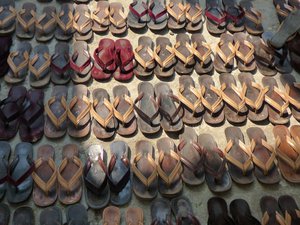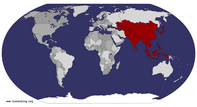Advertisement
Published: March 10th 2014

 monks' sandals
monks' sandals
Note the one untidy one top rightOn the Road to Mandalay: We traveled to Mandalay from Kalaw by bus. It took eight hours and the journey started by winding down from the hills through a series of hairpin bends which the bus driver carefully negotiated. In addition to a driver each bus has a Bus Boy whose job is to stand on the left at the front of the bus where the driver should be as they drive on the right but have right hand drive vehicles so he is not, and 'spot' for the driver, make sure no one gets run over when getting on and off the bus, jump off and pay for tolls and guide and bus when reversing, etc, and get very hands on if any mechanical work is required - you should have seen the state of ours after a wheel needed changing and he had been rolling in the dust and oil!
Once out of the hills we were on the dry Shan Plateau, the central dry zone, which is flat flat flat and stretches out of sight as a brown, sun baked scene. The scenery was monotonous but it was interesting to see rural life going on with people
farming their land with hand tools and using their oxen to pull their carts. No doubt when the rain starts in mid-May things will become beautifully green.
On the journey we did see a German register box van type lorry which I think was being used as a camper van with no windows (for extra security?). Our guide says that foreign vehicles are only allowed into Burma at the moment with a special permit and also need some kind of escort. At one place we stopped briefly for a loo break we saw large blocks of ice for sale. They were covered in rice husks to stop them melting and we were told they last about five days - pretty impressive in 36°C temperature.
To entertain us the guide played us a recording of Rudyard Kipling's poem 'Mandalay' read by John Nixon who has a lovely London accent and brought the poem to life wonderfully. See the end of this entry for the poem and/or listen to John Nixon read it at: www.youtube.com/watch?v=Bm9ItmU-kmg . He also played us a BBC documentary about the advent of the Buddhist faith. This is another example of the

 Moat of Mandalay Palace
Moat of Mandalay Palace
Mandalay Hill in the background which is part of the Himalayas foothillsextra effort our guide goes too to make the trip so great as well as informing us what we are seeing out of the window, whether it is a quarter mile long queue to buy a SIM card or a historical building, and telling us interesting facts about the old and the new of Burma.
Mandalay's streets are laid out on a grid system on the bank of the Irrawaddy River and the city seems to sprawl for a long way with everything spread out. Set, the guide, spoke of various fires over the last 150 years destroying large sections of the city but it was a little difficult to figure out exactly what he meant. I looked on the internet and found a report of 200 houses being destroyed by fire in April 2013 and of course the Mandalay Palace and Fort in 1945.
In Mandalay we have visited a number of the sites as well as some cottage industries as our guide calls them. We visited gold leaf makers (big business in Myanmar with people applying gold leaf to Buddha's in the temples everywhere covering up the original shape and turning them into amorphous

 entrance to Mandalay Palace and Fort
entrance to Mandalay Palace and Fort
Tatmadaw are the Myanmar Armed Forcesblobs), marble statue making street (very dusty), bronze casting works (not a pair of safety boots or goggles in sight), wood carving - amazingly intricate work and a jewellery shop (why?). Whilst we were at the jewellery shop two of the men and the guide quietly disappeared off to look at the nearby football stadium and were welcomed with open arms and given a tour by the stadium manager.
We visited the Mandalay Palace and Fort which was a reconstruction done in the late 1990s after it was destroyed by fire in 1945. The fort is surrounded by a moat and the area around the outside of the moat used for early morning walks and exercise.
We visited a couple of record breaking sites: the world's largest book and the world's longest wooden footbridge, the Udain Bridge. The book is 729 marble slabs on which the entire Buddhist scriptures are written are located at the Kuthodaw Pagoda. I was expecting something that actually looked like a book but it was in fact marble slabs mounted on 729 white stupas laid out in straight rows around a large central gold stupa. Set told us that the Kuthodaw
Pagoda has recently been UNESCO listed. The teak Shwenandaw Monestry was a beautiful example of carving. It is also known as the Golden Palace but today all the gilding has worn away and it looks like it could do with a coating of wood preservative. We had a one hour boat journey to visit the unfinished pagoda at Mingun. Had it been completed it would be the largest in the world but as it is it is an unstable pile of bricks having been badly damaged by earthquakes, including some quite recently. Our return journey was like being in colonial days as we drank gin and sodas (tonic seems rare here) organised by the guide as the sun set over the Irrawaddy River in the lovely cooler late afternoon temperature. Three people even saw an Irrawaddy dolphin break the surface of the water for a moment.
One of the best experiences we have had the whole trip was when we visited the Shwe Kyin Monestry where some novice monks were to be invested that day and the celebrations were under way. The family sponsoring the event encouraged us to join in and we were even invited to
lunch with them which we did. It was interesting to talk with them and learn what was going on and a little about their lives. The boys' sisters were also present and the children were dressed up almost like bridesmaids including eye makeup and lipstick, so it was almost impossible to tell the boys from the girls. Unfortunately we had to leave before the ceremony where the boys' hair is cut off and heads shaved and their monks robes put on.We also visited a show of traditional dance which thankfully only lasted an hour and included amongst other things my third viewing of the Rama and Sita story.
One more blog entry to follow for this trip once I have resolved a formating issue with the SD card in my camera ( fingers crossed!).
Mandalay by Rudyard Kipling By the old Moulmein Pagoda, lookin' eastward to the sea,
There's a Burma girl a-settin', and I know she thinks o' me;
For the wind is in the palm-trees, and the temple-bells they say:
"Come you back, you British soldier; come you back to Mandalay!"
Come you
back to Mandalay,
Where the old Flotilla lay;
Can't you 'ear their paddles chunkin' from Rangoon to Mandalay,
On the road to Mandalay,
Where the flyin'-fishes play,
An' the dawn comes up like thunder outer China 'crost the Bay!
'Er petticoat was yaller an' 'er little cap was green,
An' 'er name was Supi-yaw-lat—jes' the same as Theebaw's Queen,
An' I seed her first a-smokin' of a whackin' white cheroot,
An' a-wastin' Christian kisses on an 'eathen idol's foot:
Bloomin' idol made o' mud—
What they called the Great Gawd Budd—
Plucky lot she cared for idols when I kissed 'er where she stud!
On the road to Mandalay,
Where the flyin'-fishes play,
An' the dawn comes up like thunder outer China 'crost the Bay!
When the mist was on the rice-fields an' the sun was droppin' slow,
She'd git her little banjo an' she'd sing "Kulla-lo-lo!"
With 'er arm upon my shoulder an' 'er cheek agin my cheek
We uster watch the steamers an' the hathis pilin' teak.
No!

 Inside Mandalay Palace grounds
Inside Mandalay Palace grounds
A reconstruction done in the late 1990syou won't 'eed nothin' else
But them spicy garlic smells,
An' the sunshine an' the palm-trees an' the tinkly temple-bells;
On the road to Mandalay,
Where the flyin'-fishes play,
An' the dawn comes up like thunder outer China 'crost the Bay!
I am sick o' wastin' leather on these gritty pavin' stones,
An' the blasted Henglish drizzle wakes the fever in my bones;
Tho' I walks with fifty 'ousemaids outer Chelsea to the Strand,
An' they talks a lot o' lovin', but wot do they understand?
Beefy face an' grubby 'and—
Law! wot do they understand?
I've a neater, sweeter maiden in a cleaner, greener land!
On the road to Mandalay,
Where the flyin'-fishes play,
An' the dawn comes up like thunder outer China 'crost the Bay!
Ship me somewheres east of Suez, where the best is like the worst,
Where there aren't no Ten Commandments an' a man can raise a thirst;
For the temple-bells are callin', and it's there that I would be—
By the old Moulmein Pagoda, looking

 Monk in waiting
Monk in waiting
He does look a little nervouslazy at the sea.
On the road to Mandalay,
Where the old Flotilla lay,
With our sick beneath the awnings when we went to Mandalay!
Oh the road to Mandalay,
Where the flyin'-fishes play,
An' the dawn comes up like thunder outer China 'crost the Bay!
Elephints a-pilin' teak
In the sludgy, squdgy creek,
Where the silence 'ung that 'eavy you was 'arf afraid to speak!
On the road to Mandalay, etc.
But that's all shove be'ind me—long ago an' fur away,
An' there ain't no 'busses runnin' from the Bank to Mandalay;
An' I'm learnin' 'ere in London what the ten-year soldier tells:
"If you've 'eard the East a-callin', you won't never 'eed naught else."
Advertisement
Tot: 0.154s; Tpl: 0.017s; cc: 10; qc: 55; dbt: 0.0583s; 1; m:domysql w:travelblog (10.17.0.13); sld: 1;
; mem: 1.2mb






















